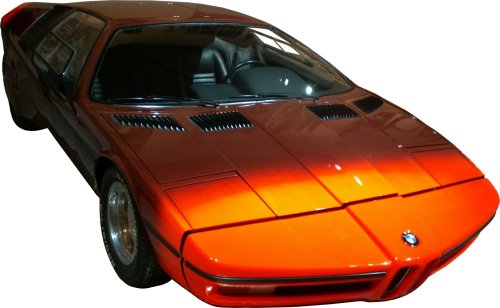 BMW 2 - 1972 Turbo X1 BMW 2 - 1972 Turbo X1

BMW Turbo X1 (E 25) 1.990 cm3 (89,0 * 80,0), 6,8 : 1, Turbocharger, mechanical fuel injection, 230 Nm 4000/min, max. 206 kW (280 HP) 7100/min, 4-speed, double wishbone
torsion/coil springs, disks ventilated, 4,16/2,4/1,88/1,1 m, 300 litres, 980 kg (dry), 250 km/h, 1972
It is easily confused with the M1 and is sometimes even regarded as its prototype. But the M1 comes 6 years later. While externally there are quite similarities, the technical basis is fundamentally different despite both
mid-engine. The M1 has a longitudinally mounted six-cylinder, the X1 Turbo a transversely arranged four-cylinder.

1972 the Olympic Summer Games take place in Munich. The tent roof opposite BMW is famous. Literally at the last minute, the decision was made to build a
mid-engine sports car prototype. And it's exactly this tight timeframe that seems to suit designer Paul Bracq, because nobody can influence his decisions.

The result is an icon of which the designer is still justifiably proud until today (see video). The E22 project was chosen as the substructure, an attempt to equip the E121 sedan with a transverse engine in front of the rear
axle. The engine was replaced with the turbo two-liter for the 2002 tii currently being under development and a project easily to get much more power of it.
| Can only be started when driver is wearing seat belt. |
What is created in day and night work is actually a safety sports car. Special front and rear parts are designed to absorb energy in an accident of an impact by deformation. The ideas here are inspired by the especially
strongly increasing safety regulations in the USA. Compared to the bulky bumpers everywhere, this is a thoroughly successful solution, even if this nose does not yet have the desired softness due to lack of time.

Enlargement: kfz-tech.de/P11 type in your browser!
The actual body is made of steel sheet at Michelotti, again a difference to the M1. In the pictures above, the color difference across the bow is by no means due to shading, but here the bright orange actually turns into a
dark red, the back exactly the other way round. The picture below clearly shows the color difference. It was meant to be another security feature.

Enlargement: kfz-tech.de/P12 type in your browser!!
The interior design is done by BMW itself. This is where Check Control appears for the first time. Everything is checked here and displayed in case of errors, even the reversing light (picture below). It's astonishing that
the usual round instruments are missing here, dominating everything, the speedometer using a sliding-bar label. But is it a good idea to hide a tachometer on the lower right with an engine rotating up to 7000/min (or
more)?

It gets even crazier. Whether it worked from the beginning is doubtful, but this vehicle already has a radar sensor and a display for the distance. Almost 50 years ago, who would have thought that? The lateral acceleration
is also displayed. In the meantime even ABS is available, as the corresponding indicator light shows.

Enlargement: kfz-tech.de/P10 type in your browser!!
The presentations were so successful that a second Turbo X1 was built. The idea was to turn the prototype into a series product, with larger engines up to V12. But although one imagines its composition from two in-line
six-cylinder engines so simply, not even for the M1 one stood ready. It wasn't until 1987 that a V12 went into series production. Then even the M1 had long since reached the end of its production life.

| Deutsche Untertitel möglich . . . |
|